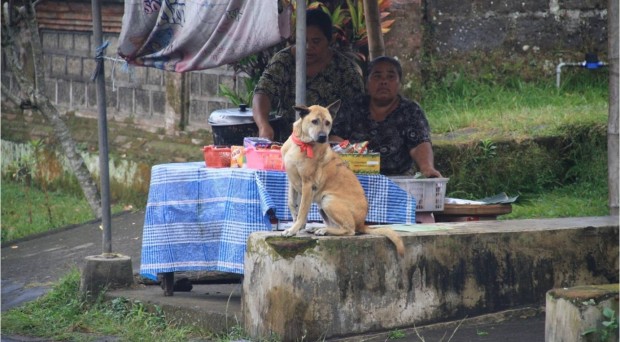
Rabies is responsible for an estimated 55,000 to more than 70,000 human deaths annually worldwide, occurring mostly in Asia and Africa.
How the virus came to Bali
The rabies virus is endemic in 24 of the 33 Indonesian provinces where there have been numerous outbreaks in the last few decades. A popular tourist destination, the island of Bali, Indonesia, remained free from rabies until 2008. However in November of that year, fishermen travelling with an infected dog from a neighboring island introduced the virus.
The initial emergency response attempted to contain the disease to the southern peninsula by vaccinating dogs (the most accepted public health strategy for rabies control) and eliminating unconfined or free-roaming dogs. The disease nevertheless quickly spread throughout the island.
Mass-vaccination programs occurred in 2010, 2011 and 2013. These achieved an estimated coverage of more than 70%, which is the accepted coverage target to sustainably reduce virus circulation with a corresponding reduction in human rabies fatalities and reported rabid dogs.
This encouraged the Balinese local government to set 2015 as the official target year for rabies elimination.
Dog density in Bali
Bali is a densely populated island inhabited by some four million people and before the introduction of rabies had one of the highest dog densities in the world; the estimated dog population was between 400,000 and 800,000 before the rabies outbreak.
Ubiquitous around markets, temples, beaches, garbage dumps, and rice paddies, the majority of Bali’s dogs are owned, free-roaming, indigenous street dogs. Known to be independent, aggressive, and territorial, the Balinese street dog remains one of the most genetically diverse canine populations, related to the Australian Dingo and Chow Chow.
Socio-cultural beliefs
Aside from a unique dog population, Bali has also long been known for its unique culture, arts, and religion, and a diverse amount of anthropological research has been conducted on the island since the early Dutch colonial era.
The study was done with support from International Livestock Research Institute (ILRI) and International Development Research Centre (IDRC) and aimed to understand the human-dog relationship in Bali that is found multifaceted.
We found that dogs play an important role in the daily lives of Balinese communities, they help to guard houses, be companions for people working in fields or plantations, as well their roles in religion or traditional ceremonies.
More than 70% of respondents kept free-roaming dogs and only few could handle their dogs during mass vaccination.
Due to the uniqueness of the culture and the local beliefs, and encouraged by a socioeconomic aspect, a number of local practices were found to be constituting risk factors for continued rabies spread.
The study result found more than 70% of respondents kept free-roaming dogs and only few could handle their dogs during mass vaccination. While community knowledge was generally fair and attitudes were mostly positive, the community in general still maintains free-roaming dogs.
What did we find?
While there was a significant relationship observed between knowledge and educational level, and also between knowledge and the role in the community, there was no significant relationship observed between community knowledge, attitudes, and dog keeping practices.
In the specific conditions found in Bali, where there’s a need for innovative ways to move forward with a rabies control program, the uniqueness of the social and cultural contect can become an opportunity to create control activities that involve the community in different ways.
Based on community needs and their capacity, appreciating local culture and their beliefs and also considering involvement of other stakeholders including the government, the study recommended community-driven activities to continue and optimize rabies control program in Bali.
An ecosystem to health approach (ecohealth approach) can be adopted and can become a golden approach to support any efforts on saving community from the dangerous disease.
Comments